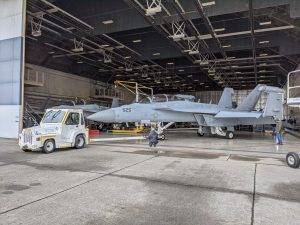The Navy started a five-year EA-18G Growler Capability Modification (GCM) program this month to upgrade capabilities on the Growler electronic warfare aircraft.
The service’s F/A-18 and EA-18G program Office (PMA-265) commenced the program at Naval Air Station (NAS) Whidbey Island, Wash., the Growler fleet homeport, the Navy said March 19. According to a Navy photo description, the first aircraft was inducted into the program on March 3.

The Growler is a variant of the F/A-18 that focuses on jamming radar and communications signals of opponents.
The Growler is set to receive several modifications to support the upcoming release of the Next Generation Jammer Mid-Band (NGJ-MB) pod, the AM/ALQ-249(V)1. The Navy said these modifications will focus on updating the aircrafts’ Airborne Electronic Attack (AEA) and mission systems, “enabling future capability growth for the U.S. Navy’s 160 EA-18Gs that serve a critical role in jamming radar and communications signals of threat forces, hindering their ability to detect and track U.S. and allied military forces.”
GCM is set to integrate advanced datalinks and the NGJ-MD pod to provide a significant increase in electronic attack capability over the current AN/ALQ-99 Tactical Jamming Systems pod. The Navy said that current pod has been in use since the 1970s.
The NGJ program is how Naval Air Systems Command is replacing and augmenting the current ALQ-99 tactical jammer system. The new jammer program is split into low-, mid- and high-band frequency increments.
This NGJ-MB system was developed by Raytheon Technologies [RTX]. The Navy awarded Raytheon a $1 billion contract in 2016 to design, manufacture, demonstrate and test the mid-band jammer (Defense Daily, April 15, 2016).
The Navy said the first EA-18G production aircraft delivered to the service in 2007 was the first aircraft inducted for this GCM program.
PMA-265 coordinated with NAS Whidbey Island as well as AEA Systems Program Office (PMA-234); Commander Electronic Attack Wing Pacific, Naval Surface Warfare Center Crane, Ind.; Fleet Readiness Center Northwest; and aircraft producer and industry partner Boeing [BA] “to ensure overall cost, schedule and performance metrics are met.”
Boeing said modifications are focused on updating the Growlers’ structural and mission systems architecture, allowing future capability growth in the aircraft. The aircraft’s ALQ-218 receiver system will receive the Airborne Electronic Attack System Enhancements modification, allowing the Growler to operate in more complex electromagnetic environments.
The company said this upgrade package is similar to the F/A-18F Super Hornet Block III upgrades. Boeing is upgrading existing Super Hornets to a Block III configuration while producing the newer aircraft. Block III upgrades include conformal fuel tanks to increase range, extending the aircraft lifespan to 10,000 flight hours, a smaller radar signature, upgrades to sensors and communications, new datalinks and computers, and enhanced engines.
Last year, Boeing delivered the first two Block III Super Hornet test aircraft for the Navy for flight testing (Defense Daily, June 17, 2020).
Other modifications include expanding the aircraft’s information pipeline for more secure and rapid data transfer to other aircraft and platforms as well as improving data processing speed, the company said.
“As the first major upgrade to the platform since its inception, the GCM will allow the Growler community to maintain the advantage in the electromagnetic spectrum and lay the basis for future upgrades to keep the aircraft relevant into 2040,” Cmdr. Chris Gierhart, PMA-265 Growler Systems Integration lead, said in a statement.
“These modifications provide the warfighter a significant leap in capability across the electromagnetic spectrum, improving combat support to front-line strike fighters of U.S. joint and allied forces,” he added.
“As the world’s premier electronic attack platform, we’re starting this program for the EA-18G Growler in solid partnership with the Navy. These modifications will position it to meet the threats of today and those in the future,” Mark Sears, Boeing vice president of Fighters and Strike Product Support, said in a statement.
The Navy underscored previously no major aircraft modification line existed at NAS Whidbey Island.
Boeing said the program schedule plans for all Navy EA-18Gs to be modified within five years, with full rate modification expected to start this June.
Previously, in 2019 Boeing said it started development work for this set of upgrades to the Growlers, called the Block II configuration (Defense Daily, May 7, 2019).